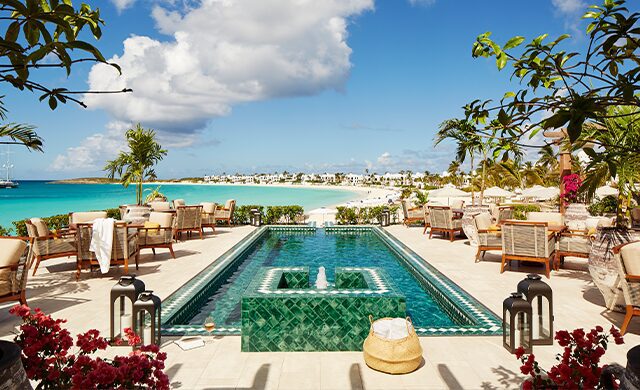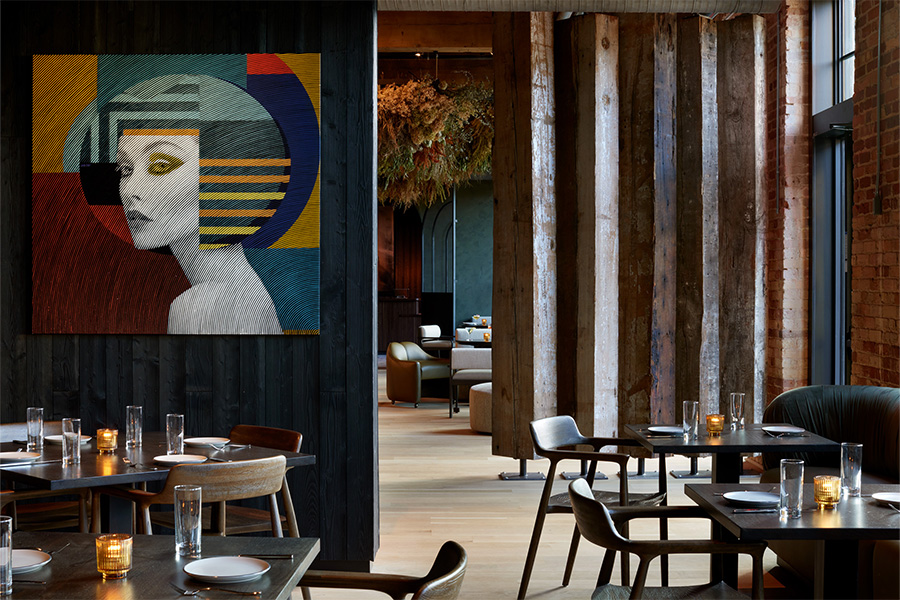Uncertainty and economic despair continue to besiege businesses around the world as a result of the COVID-19 pandemic, with tourism and hospitality among the hardest hit industries.
According to the World Tourism Organization, a United Nations specialized agency, international tourism could decline by up to 80 percent in 2020. Meanwhile, the U.S. Travel Association indicates that a $519 billion decline in national travel spending this year will yield a total loss of $1.2 trillion in economic output, more than nine times the impact of 9/11 on travel sector revenue.
Despite the grim statistics, Roger Dow, president and CEO of the U.S. Travel Association, believes “travel will come back faster than we think. After 9/11, people said they wouldn’t travel internationally again. Then, the Great Recession was followed by 10 of the best years for hotels.”
There are other glimpses of optimism, including Dow and his team’s efforts to implement a tax-deductible domestic travel credit. Additionally, according to a May edition of the U.S. Travel Association and MMGY Travel Intelligence’s TIPS report, as states reopen, 68 percent of travelers say they feel safest in a vehicle of their own. This bodes well for road trips, especially to open-space locations like beaches and national parks.
Crucially, the report shows that safety is far more valuable than price deals. Pent-up, curious travelers will be more apt to take cruises, dine out, and stay at hotels if they have peace of mind that these settings are prioritizing their health above all else, especially before a vaccine or treatment is widely available.

But owners, operators, and designers have a seemingly confounding task before them: providing consistency against a backdrop riddled with unknowns. Combining heightened hygiene practices and touchless technology with intentional design, all the while continuing to showcase their brands’ distinctive personalities without wavering from the notion of human connection, will be a tough but necessary maneuver.
Priorities were shifting before the pandemic, with travelers desiring the meaningful than the rote. Markus Schreyer, vice president of the Americas at Design Hotels, which has 350 member properties, expects that mindset to expand. “Guests seek sanctuaries where they can give back and learn something.” A hotel’s aim, he adds, has to be bigger than just checking into
a room.
Adam Rolston, creative and managing director and partner at New York’s INC Architecture & Design, sees this moment as an accelerator, not a disruptor. Coming from an age of excess, he foresees the rise of human-centered design strategies rooted in sustainability and wellness that reaffirm people’s “relationship to the real world. How things feel emotionally and to the touch are going to be as important as how they look.”
CRUISING
The cruise industry, according to Cruise Lines International Association, generates more than $150 billion per year in global economic activity and supports over 1.2 million jobs worldwide.
A return to such numbers—the Centers for Disease Control and Prevention (CDC) has a no-sail order in place through July 24th—will require tackling not only the hurdles faced by the entire hospitality realm, but overcoming the stigmas of vessels denied port access and sick passengers stranded at sea that were fostered by media coverage at the outset of the crisis.
“It felt that cruises were targeted, and by their nature cruise ships have a concentrated population in one finite space,” says Paris Swann, associate vice president of architectural design for Celebrity Cruises at Royal Caribbean Cruises. “What was not represented in that was all of the efforts toward hygiene and safety that we have historically had on our ships.”
Many cruise operators were not ready to speak at the time of writing as they continue to navigate a complex new environment that requires solid planning about best practices.
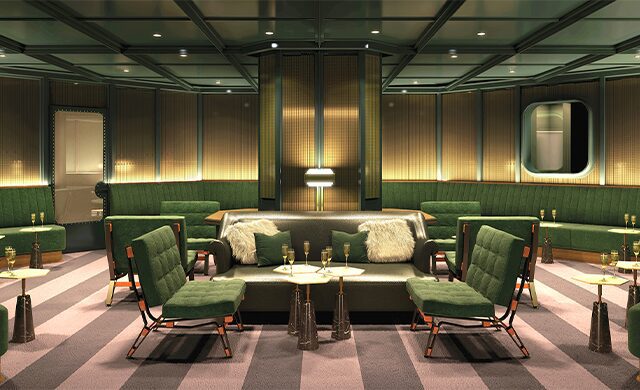
Virgin Voyages, which delayed the launch of its first ship, the Scarlet Lady, to October, said in a statement to HD that its “The Safest Way To Travel” initiatives will “include additional screening measures and testing for crew and [passengers], reduced ship capacity, enlisting highly trained medical staff, and leveraging our enhanced digital experience.” Virgin will also limit large groups at events and eliminate buffets throughout its 20-plus eateries, a plan that was in the works before COVID-19.
Likewise, Royal Caribbean Cruises has proposed to the CDC a slate of new parameters, measures, and capacities, including dedicated circulation pathways and on-board ICU and quarantine zones. “We’re looking at every single touchpoint the guest encounters where there’s a surface that’s shared with multiple users, and every interaction point between our crew and guests, and how to make sure those are as safe as possible,” Swann says.
There is much for Swann and her team to ponder, like reimagining self-serve buffets, providing guests with entertainment from a distance, implementing digital wayfinding as an alternative to touchscreens, and regulating HVAC systems so there is no fear of sharing the same air with potentially infected passengers.
BG Studio president Francesca Bucci, who has designed 33 ships, says “The price of luxury will be hygiene and space.” Much like hotels, expect an emphasis on sustainable materials, durable surfaces like copper, and technology. She points out, however, that the cruise industry has always been quick to adopt new protocols due to scrutiny by the CDC. “The industry is resilient and forward looking,” she says. “In a sense, they have this knowledge already, and it needs to be amplified on a bigger scale than before.”
Yet, Bucci and Swann are buoyed by the loyal cruise fans who are already forging ahead with new bookings. In fact, according to online cruise marketplace CruiseCompete.com, there has been a 40 percent increase in bookings for 2021 compared with 2019, with only 11 percent of them coming from cancelled 2020 trips. “I am 110 percent confident the traveler will come back,” Swann says. “They’re just going to need something different from us.”
RESTAURANTS
There are 15.6 million restaurant industry jobs in the U.S., but in April, the National Restaurant Association reported that in the midst of the public health crisis, eight million workers have been laid off or furloughed. By the end of 2020, the organization anticipates that restaurants will see $240 billion in losses, and sadly, some industry staples have shuttered for good.
“We help define neighborhoods, we help define cities, and right now we need help,” says Kevin Boehm, partner at Chicago-based Boka Restaurant Group, which owns and operates 23 F&B venues. “We’re a bit of an endangered species. If things do not change, 80 percent of restaurants will go out of business in the U.S. Everybody is just trying to scratch, crawl, and grind to get to a year from now.”

Mandatory restaurant shutdowns came suddenly, with many owners attempting to save staff and boost community morale by pivoting to delivery and take-out. The Paycheck Protection Program (PPP), designed to aid small businesses during the COVID-19 pandemic, was not well-equipped for restaurants (although legislation approved at the end of May aims to make it more accessible), and the industry took significant action, with powerhouse chefs and restaurateurs like José Andrés, Naomi Pomeroy, Tom Colicchio, and Boehm banding together to establish the Independent Restaurant Coalition (IRC) and advocate for the survival of restaurants on the federal level.
Donnie Madia, partner at One Off Hospitality in Chicago with 12 concepts in its portfolio, is also a member of the Chicago Hospitality Coalition. “We’re fighting for one consistent goal across both platforms: changing policy to help all restaurants stay open and to safely bring all of our employees back to work,” he says.
A new normal
As restaurant owners find the support they need and begin to open on a state-by-state and stage-by-stage basis, there are other logistical obstacles ahead. In high-density cities like New York, where the virus has been particularly brutal, it is bound to take time to get dining rooms operating at full capacity, which makes the need to increase outdoor dining options an urgent one.
David Rockwell, founder and president of New York-based Rockwell Group has found one solution. In collaboration with the NYC Hospitality Alliance, he created a safe, cost-effective alfresco dining template for restaurants to execute with ease. Adaptable to different locations and settings, the kits incorporate organic design touches like open decking, planter benches, and island sidewalks.
When indoor dining does become a possibility, the layout will be dictated by social distancing, “which poses inherent challenges given our intimate space and open communal seating,” says Camilla Marcus, chef and owner at the New York zero-waste restaurant West-Bourne. Marcus, who is on the IRC leadership team and a member of the citywide Relief Opportunities for All Restaurants (ROAR) organization, is not deterred. She says all aspects of restaurants—model, menu, service—will be upended in the new normal, “and our response must, and will, be innovative. This is a rigorous test for us to rewrite the rules of our craft.”

Already, there are smart changes in place. One Off Hospitality’s Avec restaurant, for instance, has converted a private dining room into a space allowing staff to spread out for prep work. Madia also points out that ordering meals ahead of time and pre-selecting table seats will gain traction. “In the immediate future, you will see an experience where all elements of interaction are carefully considered in advance,” he says.
Barriers between tables might become restaurant design norms, but like Rockwell, Siobhan Barry, design director and senior associate at Gensler’s New York office, sees ample room for imagination to transform the overall culture. Handwashing rituals unfolding at sinks placed in the front of dining rooms, for example, could be de rigueur. Some of Barry’s clients are already requesting them, manifesting as a “simply elegant reveal in the wall. It’s touchless, it’s not obtrusive, and it looks purposeful,” she says.
HOTELS
While some hotels have become safe havens for frontline workers and patients during the COVID-19 crisis, especially in hot zones like New York and Seattle, many have temporarily closed, causing reverberations throughout the industry.
According to hotel data firm STR, the week of April 11th was the worst single week of U.S. performance numbers on record for the hotel industry, with RevPAR, occupancy, and ADR showing year-over-year declines of 83.6 percent, 69.8 percent, and 45.6 percent, respectively. Despite this bleak news, occupancy slightly increased to 35.4 percent by the week ending May 23rd, due to weekend leisure demand and some midweek drive-to business travel. “We are in unchartered territory,” says STR’s senior vice president Jan Freitag. “[People ask] how this relates to 9/11 or 2009. It absolutely doesn’t. These are unprecedented changes.”
Cash is king
“When you’re at zero occupancy, it’s hard to get worse than that. We know we’ve hit bottom,” admits Michael Coolidge, chief investment and development officer at HRI Properties, which owns and manages a combined 62 properties, from luxury apartments to upscale hotels. “All of us on the investment side are looking at when we get back to year-end 2019 or early 2020 pre-COVID.” That, he continues, will be determined by what happens over the next six months, but there is one sure bet. “Cash is king, and everyone’s looking at just how much money they’re going to have to feed their assets.”
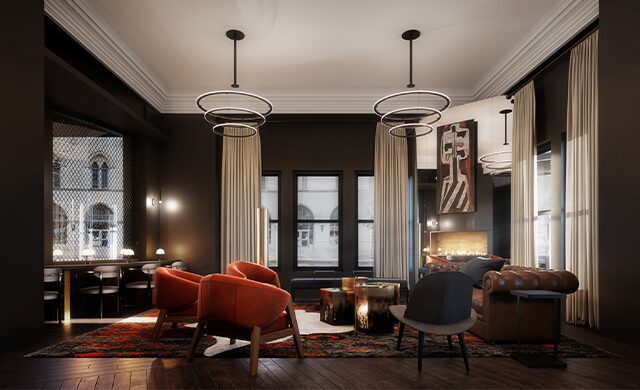
Not all ownership companies or hotels will survive, and some major public companies will push forward to take advantage of that, says Coolidge. Wade Fischer, senior vice president of design and construction at Aimbridge Hospitality, agrees that “several investment groups are waiting for these opportunities, which they anticipate will be in Q3 and Q4.” Fischer is optimistic about the future of the third-party management company, which has 1,400 hotels in its portfolio. Since February, Aimbridge has added more than 200 hotels to its pipeline. “Once we get out of this, [we’re] going to be stronger than ever,” he says.
The outlook for Hilton also looks healthy, says global head of design Larry Traxler. “We were pleasantly surprised to hear from our owners and development partners that they had every intention of moving forward with projects for the most part. Ninety percent of our 3,000-plus active projects are still ongoing.”
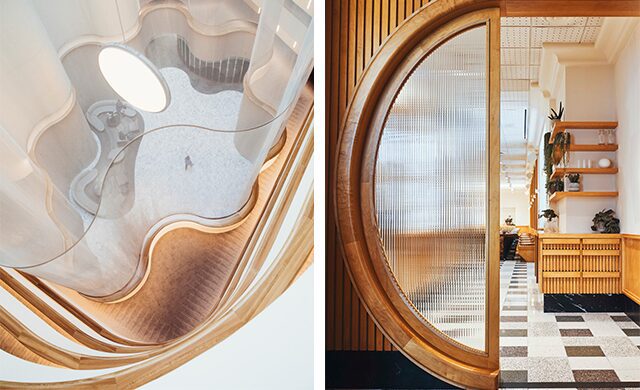
Based on a confidence survey conducted by her company for 2020, Maki Nakamura Bara, president and cofounder of the Chartres Lodging Group, which has acquired and repositioned $3 billion of hotel assets in the past 18 years, also anticipates a flourishing buying market—a departure from the previous year’s survey showing that the majority of participants were net sellers. “Overwhelmingly, more than 95 percent of people are saying they’re net buyers, which is great because when hotels get recapitalized, they tend to get renovated as well.”
Upgrading standards
Renovations, many of which were halted as a result of the pandemic, will have one primary focus when they reboot: upgraded sanitation standards. Sixteen of the largest hotel brands, along with ownership groups and management companies, are now part of the American Hotel and Lodging Association’s (AHLA) cleaning and safety program, Safe Stay. Lending the industry a unified voice, “It sets forth the guidelines on how hotels should be cleaning, the products they should be using, the social distancing that needs to take place, the use of technology to have contactless transactions, and what to do with grab-and-go items and roomservice,” says AHLA president and CEO Chip Rogers. “The next stage is looking at how to remake the cleaning and safety process on a permanent basis.” In a sense, it’s the need to move from the sharing economy to a safe economy, or a hybrid of the two.

Brands are migrating housekeeping from back-of-house to the spotlight, creating a theater around cleaning that secures guests’ trust as soon as they enter the property. Hospitality owner and operator HEI Hotels & Resorts is employing the likes of door seals, electrostatic sprayers, and partitions for high-touch areas, including the front desk. The Marriott Global Cleanliness Council is Marriott International’s holistic, multipronged approach to health and safety, incorporating intel from leaders across Marriott disciplines including housekeeping, engineering, food safety, occupational health, and associate wellbeing, as well as the installation of hand-sanitizing stations and the use of hospital-grade disinfectants. Four Seasons Hotels and Resorts has partnered with Johns Hopkins Medicine International on Lead With Care, establishing a COVID-19 advisory board and placing hygiene officers at each of its hotels. Hilton, in collaboration with RB, the maker of Lysol and Dettol, and in consultation with the Mayo Clinic’s infection prevention and control team, is unveiling Hilton CleanStay while augmenting its digital key contactless arrival experience and exploring ultraviolet light sanitation.
The powerful cleaning supplies now necessary are a reminder that hotels must also assess operations decisions through the lens of design. Stacey Greene, vice president of project management at hotel management company Pyramid Hotel Group, warns that particular sanitizing gels could destroy furniture. To prevent this, Greene says communicating with vendors is essential. “The vendor is going to make sure their product lasts because they don’t want owner-operators to say, ‘You know that nightstand you put out? I had to clean it with the wipes and it disintegrated, and you need to replace that.’”
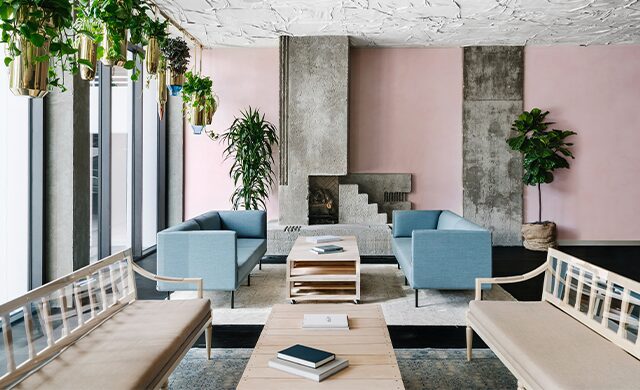
From a design perspective, Lauren Rottet, president and founding principal at Houston-based Rottet Studio, says she sees herself gravitating toward glass that is easy to clean and features a coating that “gobbles germs up like Pac-Man.” Like Greene, she is expecting luxury vinyl tile in contemporary designs to replace carpet in this new era.
The human element
Hotels are also taking into account big-picture objectives. “We don’t want to lose sight of the safety of our guests and our team members, or the fact that we’re hospitality providers, not healthcare providers,” says Traxler of Hilton.
Wellness will be exemplified in antiviral fabrics and materials that designers will now put front and center “in a way that is still warm and comforting,” adds Ian Carter, president of global development, architecture, design, and construction at Hilton. Biophilia will become more vital, he continues, “blurring the lines between indoor and outdoor spaces. Instead of incorporating screens, we’re thinking about more natural materials and greenery in our design.”

Neil Jacobs, CEO of Six Senses Hotels Resorts Spas, is navigating the road ahead by “broadening and deepening those pillars” of sustainability and wellness that have anchored the brand from the get-go. In addition to looking at programming that is geared toward strengthening the immune system, his team is also focused on “how we treat people, how we behave, and what drives people to get up in the morning and go about their lives,” he says.
Despite these changes, hoteliers are faced with figuring out how to maintain a social spirit in their properties. “It’s always going to be customer needs that are the driver of our experience,” says Brad Wilson, president of Ace Hotel Group. While some hotel companies are contemplating eliminating such staples as roomservice and minibars, Wilson has a contrary thought: “In a world where, if anything, we’ll probably turn inward, maybe safe roomservice is better than no roomservice, and maybe a safe minibar should be expanded.”
With such best practices anticipated to be at the forefront for hotels, storytelling, community building, and experiences will be more important than ever. Brad Nichols, principal at private equity company Geolo Capital, whose portfolio of hotels skews to urban markets and relies on F&B for 20 to 40 percent of its profits, says the concept of physical distancing is “antithetical to basic human nature.” While guest and employee safety is top of mind, many hoteliers, including Sydell Group founder and CEO Andrew Zobler, are making temporary design changes while the world awaits a return to normal. A hotel, he says, still needs to possess elements of entertainment and fun so “it’s a place people want to be.”

Despite what will be necessary adjustments, at least in the short term, many have faith in people’s ability to adapt. “I don’t want people to not feel the energy and excitement when they come into one of our hotels. I’m for staying closed until [we] can deliver on all of those things,” says visionary hotelier Ian Schrager, founder of the EDITION and PUBLIC brands.
The industry is not on the cusp of a paradigm shift, he continues. “I’ve never seen a calamity in the history of humanity that didn’t return to normal, from Noah’s Ark on. We’ll make slight adjustments, but we are human beings. We are wired the same way and we will continue on with the way we were behaving before.”
This article originally appeared in HD’s June 2020 issue.
Photography and renderings by Azeez Bakare Studios, Chase Daniel, Alice Gao, Adrian Gaut, Michael Miller, and Kiattipong Panchee

